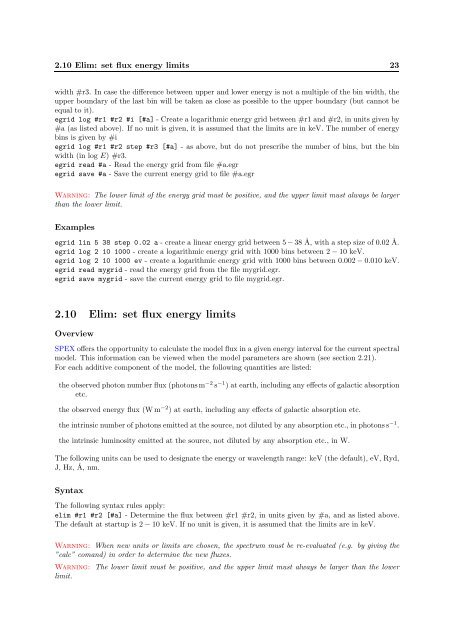SPEX Reference manual (PDF) - SRON
SPEX Reference manual (PDF) - SRON
SPEX Reference manual (PDF) - SRON
You also want an ePaper? Increase the reach of your titles
YUMPU automatically turns print PDFs into web optimized ePapers that Google loves.
2.10 Elim: set flux energy limits 23<br />
width #r3. In case the difference between upper and lower energy is not a multiple of the bin width, the<br />
upper boundary of the last bin will be taken as close as possible to the upper boundary (but cannot be<br />
equal to it).<br />
egrid log #r1 #r2 #i [#a] - Create a logarithmic energy grid between #r1 and #r2, in units given by<br />
#a (as listed above). If no unit is given, it is assumed that the limits are in keV. The number of energy<br />
bins is given by #i<br />
egrid log #r1 #r2 step #r3 [#a] - as above, but do not prescribe the number of bins, but the bin<br />
width (in log E) #r3.<br />
egrid read #a - Read the energy grid from file #a.egr<br />
egrid save #a - Save the current energy grid to file #a.egr<br />
Warning: The lower limit of the energy grid must be positive, and the upper limit must always be larger<br />
than the lower limit.<br />
Examples<br />
egrid lin 5 38 step 0.02 a - create a linear energy grid between 5−38 Å, with a step size of 0.02 Å.<br />
egrid log 2 10 1000 - create a logarithmic energy grid with 1000 bins between 2−10 keV.<br />
egrid log 2 10 1000 ev - create a logarithmic energy grid with 1000 bins between 0.002−0.010 keV.<br />
egrid read mygrid - read the energy grid from the file mygrid.egr.<br />
egrid save mygrid - save the current energy grid to file mygrid.egr.<br />
2.10 Elim: set flux energy limits<br />
Overview<br />
<strong>SPEX</strong> offers the opportunity to calculate the model flux in a given energy interval for the current spectral<br />
model. This information can be viewed when the model parameters are shown (see section 2.21).<br />
For each additive component of the model, the following quantities are listed:<br />
the observedphoton number flux (photonsm −2 s −1 ) at earth, including anyeffects of galacticabsorption<br />
etc.<br />
the observed energy flux (Wm −2 ) at earth, including any effects of galactic absorption etc.<br />
the intrinsic numberof photonsemitted at the source, not diluted byany absorptionetc., in photonss −1 .<br />
the intrinsic luminosity emitted at the source, not diluted by any absorption etc., in W.<br />
The following units can be used to designate the energy or wavelength range: keV (the default), eV, Ryd,<br />
J, Hz, Å, nm.<br />
Syntax<br />
The following syntax rules apply:<br />
elim #r1 #r2 [#a] - Determine the flux between #r1 #r2, in units given by #a, and as listed above.<br />
The default at startup is 2−10 keV. If no unit is given, it is assumed that the limits are in keV.<br />
Warning: When new units or limits are chosen, the spectrum must be re-evaluated (e.g. by giving the<br />
”calc” comand) in order to determine the new fluxes.<br />
Warning: The lower limit must be positive, and the upper limit must always be larger than the lower<br />
limit.

















